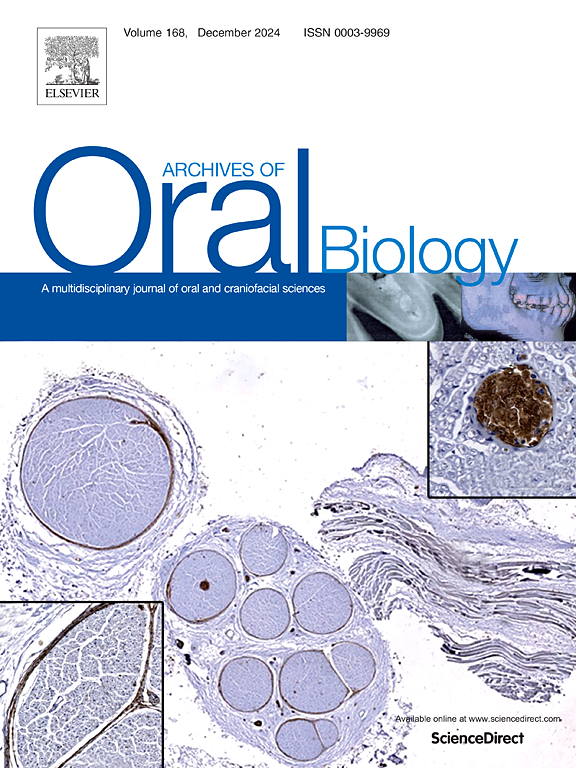Synergistic potential of Bauhinia holophylla leaf extracts with conventional antifungals in the inhibition of Candida albicans: A new approach for the treatment of oral candidiasis
IF 2.2
4区 医学
Q2 DENTISTRY, ORAL SURGERY & MEDICINE
引用次数: 0
Abstract
Objective
This study investigated the combination of Bauhinia holophylla (Bong.) Steud. leaf extracts with conventional antifungal agents, highlighting the extracts' potential as adjuvants in treating oral candidiasis.
Design
Ethanolic and aqueous extracts of B. holophylla leaves were analyzed using ultra-high-performance liquid chromatography with a diode array detector (UHPLC-DAD) to assess their chemical composition. Their Minimum Inhibitory Concentration (MIC) against standard strains of Candida albicans and isolates from oral mucosa was determined. Additionally, the potential synergistic effects with chlorhexidine gluconate, nystatin, and fluconazole were investigated, along with their impact on inhibiting and disrupting biofilm formation, germ tube formation of C. albicans, and cytotoxicity in human erythrocytes.
Results
Protocatechuic acid, epicatechin, and rutin were identified in both extracts. They exhibited fungistatic activity with a median minimum inhibitory concentration (MIC50) of 15.62 µg/mL for the ethanolic extract (EEB) and 62.50 µg/mL for the aqueous extract (AEB) against C. albicans. In growth kinetics, both extracts reduced the viable cell count of C. albicans by 2 logs after 24 h compared to the positive control. The extracts reduced germ tube formation by 81.6 % for EEB and 86.3 % for AEB. The synergistic combination with fluconazole and nystatin resulted in a 50 % reduction in the concentration required to inhibit C. albicans growth. No hemolytic activity was detected in human erythrocytes at the tested concentrations.
Conclusion
Both ethanolic and aqueous extracts show promising potential as adjuvants in managing oral candidiasis. Notably, the aqueous extract is advantageous due to its non-toxic solvent, cost-effectiveness, and ease of preparation.
紫荆叶提取物与传统抗真菌药在抑制白色念珠菌方面的协同潜力:治疗口腔念珠菌病的新方法
设计采用超高效液相色谱-二极管阵列检测器(UHPLC-DAD)对洋紫荆叶的乙醇提取物和水提取物进行分析,以评估其化学成分。测定了它们对白色念珠菌标准菌株和口腔黏膜分离菌株的最低抑制浓度(MIC)。此外,还研究了它们与葡萄糖酸氯己定、硝司他丁和氟康唑的潜在协同作用,以及它们在抑制和破坏生物膜形成、白念珠菌芽管形成和人体红细胞细胞毒性方面的影响。结果在两种提取物中都发现了儿茶酸、表儿茶素和芦丁。乙醇提取物(EEB)和水提取物(AEB)对白僵菌的最小抑菌浓度(MIC50)中位数分别为 15.62 µg/mL 和 62.50 µg/mL。在生长动力学方面,与阳性对照相比,两种提取物都能在 24 小时后将白僵菌的存活细胞数减少 2 个对数值。EEB和AEB提取物分别减少了81.6%和86.3%的芽管形成。与氟康唑和硝司他丁的协同作用使抑制白僵菌生长所需的浓度降低了 50%。结论乙醇提取物和水提取物都显示出作为治疗口腔念珠菌病的辅助剂的巨大潜力。值得注意的是,水提取物因其溶剂无毒、成本效益高且易于制备而具有优势。
本文章由计算机程序翻译,如有差异,请以英文原文为准。
求助全文
约1分钟内获得全文
求助全文
来源期刊

Archives of oral biology
医学-牙科与口腔外科
CiteScore
5.10
自引率
3.30%
发文量
177
审稿时长
26 days
期刊介绍:
Archives of Oral Biology is an international journal which aims to publish papers of the highest scientific quality in the oral and craniofacial sciences. The journal is particularly interested in research which advances knowledge in the mechanisms of craniofacial development and disease, including:
Cell and molecular biology
Molecular genetics
Immunology
Pathogenesis
Cellular microbiology
Embryology
Syndromology
Forensic dentistry
 求助内容:
求助内容: 应助结果提醒方式:
应助结果提醒方式:


